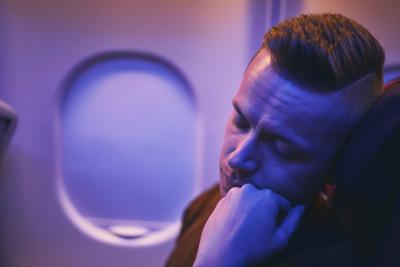Nothing undermines the joy of travel quite like a bad case of jet leg. ThatÔÇÖs why an entire industry has popped up to help deal with it, hawking solutions such as light-therapy glasses, targeted supplements, apps and coaching.
Do any of them work?
I put two popular methods to the test on a two-week journey to Asia in May. I flew from New York City, where I live, to Seoul, South Korea, and Taipei, Taiwan ÔÇö both are on the other side of the globe, a difference that is literally night and day ÔÇö and then back home.
The two apps to which I ceded control of my daily rhythms, Flykitt and Timeshifter, are personalized programs based on scientific approaches to jet lag. Both directed me when to sleep, get light exposure, drink caffeine and take supplements. But they took different approaches: Flykitt featured a heavy vitamin regimen, while Timeshifter focused on preparing for jet lag days before flying.
Both apps rely on circadian science, the study of the bodyÔÇÖs internal clocks. The central clock is in the brain and follows a roughly 24-hour cycle.
Many mental, physical and behavioural changes in the body, such as hormone release, and sleeping and waking, are influenced by the circadian clock. Research shows that exposure to light plays a key role in synchronizing these rhythms to the outside world.
Jet lag happens when the body clock falls out of sync with the local time, resulting in discomforts such as poor digestion, foggier memory and focus, and interrupted sleep.
Many sleep experts said light exposure is the key to shifting the bodyÔÇÖs internal clock. Light at strategic times can move the clock in either direction. Basically, to move it earlier, youÔÇÖll want to see light earlier in the morning than usual; to move it later, get that light exposure deeper into the night.
ÔÇťYour brain wants to be awake, but you want to be asleep,ÔÇŁ said Jamie Zeitzer, a professor of sleep medicine at Stanford University and co-director of its Center for Sleep and Circadian Sciences.
Long-haul journeys across time zones present a timing challenge: Seoul was 13 hours ahead of New York when I went and Taipei was 12 hours ahead. For most people, itÔÇÖs harder to move your sleep time earlier than it is to delay sleep.
The apps proved useful by helping me wrap my head around time zone calculations, such as the ideal time to sleep on a flight and when to blast my eyes with light to better adjust to my destination.
First up, for the New York-to-Seoul trip, was Flykitt. Its starter pack, $99 USD ($136.45) for a round trip, includes glasses that filter blue light to minimize light exposure and packs of supplements meant to target inflammation. The program, which promised to curb jet lag in just three days, began on departure day. I put my flight details into the app and answered a few questions about my caffeine intake and sleep patterns, and the app promptly churned out a detailed schedule.
On the 15-hour non-stop flight to Seoul, the program recommended only a three-hour nap, so I barely slept. Instead, I diligently studied my schedule, donned my special glasses, ate meals and took vitamins every few hours. The patented supplement protocol included vitamins B6, B12 and C; magnesium glycinate; melatonin; and omega-3 fatty acids.
Andrew Herr, who founded in Flykitt in 2022 and previously worked as a military contractor researching human performance, said he believed data shows that inflammation is a ÔÇťkey pieceÔÇŁ of jet lag and that itÔÇÖs ÔÇťexacerbated by the lower sleep or the disruptive sleep you get during travel.ÔÇŁ
At first, popping handfuls of pills was novel and funny, until it wasnÔÇÖt. The regimen had me taking about three dozen vitamins over three days, starting on the day of the flight.
I also experienced mysterious, intense thirst. I couldnÔÇÖt be sure, but I suspected the vitamins were to blame.
While I wouldnÔÇÖt say my jet lag was zapped by Day 3, I slept well and felt energized. I felt fully adjusted after five days, shortly before flying to Taiwan. FlykittÔÇÖs app told me that unassisted, this time zone alignment would generally take a little over a week.
After about a week in Taipei, I returned to New York using TimeshifterÔÇÖs guidance. This app was cheaper than Flykitt, $25 for a yearÔÇÖs subscription. No blue-light glasses, which I honestly enjoyed wearing. The only recommended supplement was melatonin, which I was to take for my first four nights back home to help with the adjustment.
While Flykitt instructed me when to avoid light, Timeshifter alerted me about times to seek it out. When I couldnÔÇÖt be outside, I turned on as many lights as I could. Standard room light is about half as effective as daylight, Zeitzer of Stanford said.
The week-long program featured a pre-flight shift two days before my return. This meant seeing light several hours before sleeping, as well as gradually pushing my sleep and wake times later, which wasnÔÇÖt practical in my final days in Taipei. I didnÔÇÖt want to sleep until 10 a.m. on my last day in the city when I could be crushing soup dumplings instead.
On my evening return flight from Taiwan, the app advised acclimating to New YorkÔÇÖs time zone, where it was daytime, by drinking caffeinated beverages deep into the night. It also suggested napping, which I found to be conflicting advice after having tea. I dozed maybe an hour or two. Back home, the regimen of light at night and melatonin to assist with sleep continued for several more days. Staying up when I was exhausted was painful without the adrenalin of being somewhere new.
It took me about five days to feel back to normal.
The bottom line: Neither program markedly shaved time off my jet lag, but I did feel more clear-headed during and after my trip and I didnÔÇÖt get sick. The severe dehydration I felt may have been anomalous, but it was a pretty big minus for me. Perhaps the biggest benefit the apps offered was confidence; science was on my side.
This article originally appeared in .

























To join the conversation set a first and last name in your user profile.
Sign in or register for free to join the Conversation